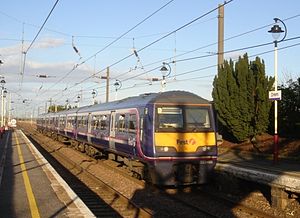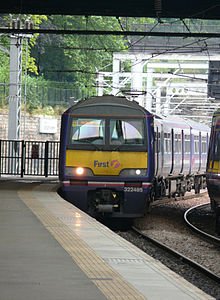- British Rail Class 322
-
British Rail Class 322 
322481 at Drem on a North Berwick to Edinburgh serviceIn service 1990 - Current Manufacturer BREL York Family name BR Second Generation (Mark 3) Constructed 1990 Refurbishment 2005 - 2007
Hunslet-Barclay, Kilmarnock[1]Number built 5 trainsets Formation 4 cars per trainset Fleet numbers 322481 - 322485 Operator Northern Rail Specifications Maximum speed 100 mph (161 km/h) Weight Total - 141.8 t (139.6 long tons) Electric system(s) 25 kV 50 Hz AC overhead Braking system(s) Air (Westcode) Gauge 1,435 mm (4 ft 8 1⁄2 in) Standard gauge The British Rail Class 322 electric multiple units were built by BREL in 1990.[2] Five 4-car units were built for the dedicated Stansted Express service from London Liverpool Street to Stansted Airport. The units were then used by First ScotRail, operating on the North Berwick Branch Line, between Glasgow Central/Edinburgh Waverley and North Berwick. The entire class 322 fleet has since moved to Northern Rail and is set to begin service in December 2011 for use around the Leeds area. The first units transferred in July 2011.
Contents
Description
In the late 1980s, British Rail (BR) was extending the electrification north from London Liverpool Street towards Cambridge. Included in this plan was the construction of new branch line, diverging from the mainline at Stansted Mountfitchet, to serve the newly built Stansted Airport, which opened in 1991. Therefore, BR decided to build a dedicated fleet of units to work the new Stansted Express service.
To reduce costs, the Class 322 units were built to the same design as the successful Class 321 units, which were still under construction for services on the GEML and WCML. Despite the Stansted route falling under the jurisdiction of Network SouthEast (NSE), the units were delivered into service in a special white livery with a broad green band, instead of the more usual NSE blue/red/white livery.
Five 4-car units were built, numbered 322481-485. Each unit consisted of two outer driving trailers, an intermediate trailer, and an intermediate motor. The technical description of the formation of each unit is DTCO+TSO+MSO+DTSO. Individual vehicles are numbered as follows:
- 78163-78167 - DTCO
- 72023-72027 - TSO
- 63137-63141 - MSO
- 77985-77989 - DTSO
The units were also the last of a long line of BR multiple units to be based on the Mark 3 bodyshell design.
Future operations
Northern Rail
The Class 322s are due to come into service with Northern Rail from December 2011, and will be used to provide additional services between Leeds, Skipton, Ilkley and Doncaster. The cascade from Scotland will also allow some of Northern’s diesel units to be transferred to the Leeds-Bradford-Manchester route.[3][4]
At the beginning of October 2011, the units are at Heaton TMD in Newcastle upon Tyne undergoing rebranding into Northern Rail livery.[citation needed]
Former operations
First ScotRail
 Class 322 No. 322485 to North Berwick entering Edinburgh Waverley station (August 2010)
Class 322 No. 322485 to North Berwick entering Edinburgh Waverley station (August 2010)
In 2001, having been made redundant on WAGN services, the entire fleet was hired to ScotRail and they were transferred north to Scotland under their own power. They were put to work the Edinburgh to North Berwick service, which allowed the elderly incumbent Class 305 units to be withdrawn. One morning and one evening peak service was provided to Glasgow Central via the relatively quiet Edinburgh-Carstairs branch of the WCML to allow the units to receive maintenance at Glasgow Shields depot as First ScotRail's facilities in Edinburgh at Haymarket and Slateford depots are for diesel traction only.
Despite the fact their use in Scotland was originally meant to be long-term, none of the units were repainted. Instead, the Stansted Skytrain branding was replaced with ScotRail logo. The units continued to be used on these services until mid-2004, when the hire period ended. They were transferred south in two batches, and were replaced on the North Berwick branch by EWS Class 90 electric locomotives hauling former Virgin Trains Mk.3 coaching stock. To enable trains to reverse, the locomotive operates in push-pull mode with a Driving Van Trailer.
In mid-late 2005, the units were transferred back to Scotland for refurbishment prior to reintroduction on the North Berwick line, which was expected to be their permanent use.[5] In Spring 2006, the first unit to be refurbished and repainted in the First ScotRail livery was unveiled.[5][1] The class were refurbished at Hunslet-Barclay, Kilmarnock, from end of 16 July 2005 until end of 9 February 2007.[1] 322481 was the first one repainted, and it took up the name that 485 owned when they previously operated the route. The remaining units have now been refurbished and repainted into First ScotRail livery.[5][1] However, one unit, no. 322481, was named "North Berwick Flyer 1850-2000".[5]
In 2010 with the introduction of Class 380 "Desiro", the North Berwick Line had a fleet replacement and began operations in June 2011. The last service operated by a Scotrail Class 322 was the 0756 North Berwick-Edinburgh service on the 2 August 2011 and all units are now being transferred to Northern Rail.
West Anglia Great Northern
Following privatisation, the fleet passed into control of the West Anglia Great Northern (WAGN) franchise. In 1996, WAGN introduced a revised Stansted Express livery, which was still mainly white, but with a yellow stripe replacing the green. At the same time, services were rebranded as the Stansted Skytrain.
Units continued to be used on these services until 1997, when they became common-user with the rest of the WAGN fleet. After this, it was common for units to turn up on London King's Cross to Peterborough services. Four of the five units were subsequently hired to North Western Trains, and two were painted in the company blue livery with gold stars. The other two units were frequently interchanged with the one remaining WAGN unit, and so were not repainted.
By 1999 the NWT units had returned to WAGN. They still did not have any specific duties to work, as dedicated rebuilt Class 317/7 units were introduced to the Stansted Airport services in 2000. The Class 322 fleet therefore remained non-standard in WAGN's fleet, so in 2001 all five units were hired to ScotRail, who operated similar Class 320 units. The class was transferred north to Scotland in two batches under their own power, routed via the West Coast Main Line.
North Western Trains
In the period 1997 to 1999, North Western Trains (NWT) hired four units from WAGN for a new Manchester Airport to London Euston service. Two of the units, nos. 322484 and 322485, were repainted into NWT's blue and gold livery, whilst the other two unspecified units remained in the revised Stansted Skytrain livery.
These services did not last long, and by 1999 the units had returned to WAGN. One of the two NWT blue units, no. 322485, was repainted back into Stansted Skytrain livery.
Fleet details
Unit Number Current Livery Vehicle Numbers Current Operator DTCO TSO MSO DTSO 322481 de-branded First ScotRail 78163 72023 63137 77985 Off lease as of August 2011.
(Northern Rail operational in December 2011.)322482 de-branded First ScotRail 78164 72024 63138 77986 322483 de-branded First ScotRail 78165 72025 63139 77987 322484 de-branded First ScotRail 78166 72026 63140 77988 322485 de-branded First ScotRail 78167 72027 63141 77989 References
- ^ a b c d "Class 322 Refurbishment 05-07". scot-rail.co.uk. http://www.scot-rail.co.uk/page/Class+322+Refurbishment+05-07. Retrieved 14 February 2011.
- ^ "Class 322 Technical data". TheRailwayCentre.Com. http://www.therailwaycentre.com/New%20EMU%20Tech%20Data/EMU_322.html. Retrieved 14 February 2011.
- ^ "Northern to get Class 322 boost from December". Railnews.co.uk. 13 April 2011. http://www.railnews.co.uk/news/general/2011/04/13-northern-to-get-class-322.html. Retrieved 22 April 2011.
- ^ "News Journal". Railway Herald (264): p. 6. 19 April 2011. http://www.rharchive.info/Issue264HIGH.pdf. Retrieved 22 April 2011.
- ^ a b c d First ScotRail unvil refurbished Class 322 - Railway Herald. Page 3. 2006-04-07. Issue 36. Retrieved 2011-09-11.
BREL Mark 3-derived family Diesel Electric Categories:- British Rail electric multiple units
- BREL products
Wikimedia Foundation. 2010.



